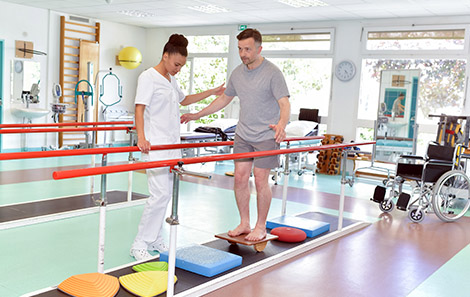Physical therapy is a dynamic profession with an established theoretical and scientific base and widespread clinical applications in the restoration, maintenance, and promotion of optimal physical function. Physical therapists:
• Evaluate and manage movement dysfunction and enhance physical and functional abilities.
• Restore, maintain, and promote not only optimal physical function but also optimal wellness and fitness and optimal quality of life as it relates to movement and health.
• Prevent the onset, symptoms, and progression of impairments of body functions and structures, activity limitations, and participation restrictions, functional limitations, and disabilities that may result from diseases, disorders, conditions, injuries, conditions of the musculoskeletal, neuromuscular, cardiovascular, pulmonary, and/or integumentary systems or the negative effects attributable to unique personal and environmental factors as they relate to human performance.
As essential participants in the health care delivery system, physical therapists assume leadership roles in rehabilitation and habilitation; performance enhancement, prevention, health maintenance, and programs that promote health, wellness, and fitness; and in professional and community organizations.
CAREER PATH
PT Musculoskeletal disorders
Orthopedic physical therapists diagnose, manage and treat disorders and injuries of the musculoskeletal system. This specialty of physical therapy is most often found in the out-patient clinical setting. Those who have suffered injury or disease affecting the muscles, bones, ligaments or tendons of the body may benefit from assessment by a physical therapist specialized in orthopedics. Orthopedic therapists are trained in the treatment of post-operative conditions, sports injuries, arthritis, and amputations, among other injuries and conditions.
PT Neurological disorders
Neurological physical therapists work with individuals who have a neurological disorder or disease which affect the brain and spinal cord as stroke, multiple sclerosis, Parkinsonism, paraplegia and quadriplegia as well as peripheral nervous system disorders.
PT Cardiac and Pulmonary cases
Cardiovascular and pulmonary rehabilitation physical therapists treat a wide variety of people with cardiopulmonary disorders as well as those who have had cardiac or pulmonary surgery.
PT Women’s Health
Physical therapists can specialize in women’s health, which refers to both specific conditions women face as well as the treatment of women at different stages of their life. Physical therapists in this specialty can work to treat conditions such as pelvic pain, osteoporosis and lymphedema, while also providing prenatal and postnatal care.
PT Integumentary system disorders
The integument or skin, which is the largest organ system of the body, constitutes 15% to 20% of the body weight. The role of the physical therapist in burn wound care has evolved over the past several decades. Physical therapists who desire to be active in wound management need to expand their knowledge through continuing education and competency-based training with a mentor. Therapists work closely with physicians and nurses to achieve rapid wound closure and deal with post burn physical complications.
PT Lymphedema Rehabilitation
Lymphedema is a swelling in the arms and/or legs, typically caused by removal or damage of the lymph nodes during cancer treatment. This swelling can be painful, limit range of motion and lead to a hardening or thickening of the skin. Physical therapy can help patients with lymphedema to restore function, reduce physical and psychologic suffering, and prevent the development of infection.
CAREER PATH

PT Pediatric disorders
Pediatric physical therapy assists in early detection of health problems as well as the diagnosis, treatment, and management of infants, children, and adolescents with a variety of injuries, disorders, and diseases that affect the brain, muscles, bones, and joints.
PT Geriatrics
Geriatric physical therapy covers numerous issues concerning people as they go through normal adult aging. Geriatric physical therapists develop individualized programs to help restore mobility, reduce pain and increase fitness.
PT sports injuries
Athletes who have sustained an injury may be very familiar with this physical therapy specialty. Physical therapists who specialize in sports medicine work to alleviate and heal injuries caused while engaging in an athletic activity.
PT Oncology cases
Physical therapists work with cancer patients to help them feel more comfortable, increase their aerobic capacity, lose weight, improve memory and strengthen any weakened muscles. They accomplish this by developing treatment plans using exercise, massage, electrical stimulation, compression garments and stretching to help patients both in the clinic and at home.
PT Amputee Rehabilitation
The amputee must be physically prepared for the prosthesis and educated about residual-limb care and learn how to use and care of both of them. Prosthetic gait training can be the most frustrating. However, once success is achieved, the amputee may look forward to resuming a normal productive life. The therapist should introduce the amputee to higher levels of activities beyond just learning to walk.









